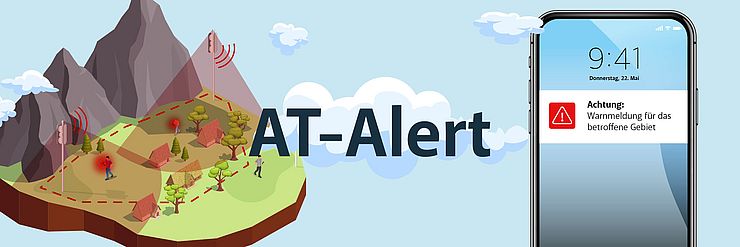AT-ALERT Cell Broadcast (English version)
Warning messages from Austria's regional warning centres and the Federal Ministry of the Interior sent directly to your mobile phone or smartphone
Cell Broadcast: What is it?
Cell broadcast is used to issue warnings - for example, of extreme weather events - via messages on mobile phones (conventional mobile phone/smartphone) directly to the population. In Austria this system is called AT-ALERT.
Specifically, warnings from the state warning centres or the federal government are sent to all mobile phones located in a specific section of the mobile network, a so-called radio cell. This means that the warnings are sent to all mobile phones located in a specific area. This means that the warning can be sent to all affected mobile phones in a targeted manner. No app or registration is required - the mobile phone simply needs to be set to receive such messages (activate & deactivate cell broadcast). The warnings are short text messages containing information about the danger and recommendations for action. A link with further information is also sent.
Each mobile device automatically registers in a radio cell via which network reception is established. The central distributor of a radio cell can then send warning messages in the opposite direction to all devices registered in it.
The advantage is that all persons in an area who are carrying a mobile phone that is set up for this purpose and ready to receive can be reached anonymously as the recipient of a cell broadcast warning message if a hazardous event occurs. This happens regardless of which country a person is from or which mobile phone provider they use. Only the current geographical location counts. Only a few seconds pass between the message being sent and appearing on the mobile phone.
The data traffic required for this is also not affected by an increased volume of mobile phone calls. Even if dialling into the cell is not possible due to overbooking, this has no influence on the data transmission of a warning message via cell broadcast. The warning messages are exclusively text messages. Images or maps are not transmitted.
Can my device receive Cell Broadcast messages?
The technology for receiving Cell Broadcast emergency alerts is integrated in most modern mobile phones and only needs to be activated. This happens automatically when you update to newer software versions of Android and iOS.
The application does not use your phone number or any other personal information. It therefore does not matter which mobile phone contract you have, where you live or work or which mobile phone operator your mobile phone is registered with.There are no costs for you as a user when you receive a cell broadcast message. No additional login, registration or app download is required.
It is not possible to provide a comprehensive list of devices in Austria that are ready to receive notifications, as a number of circumstances (operating system and version, manufacturer, hardware) are responsible for this.
However, the following devices can receive emergency notifications:
- mobile phones (Android from operating system version 11; iPhones from operating system version iOS 17.4)
- Apple Watch from Series 4 (with cellular capability)
- Older devices (2G/GSM network) can only receive the highest warning level (emergency alarm)
- iPads are not supported
For Android devices, it is also necessary to have a current version of the Google Play application installed.
You will receive an AT Alert message if you are with your device with reception capability (mobile phone and/or Apple Watch) in an area to which the warning applies or if you are entering such an area and the corresponding warning level is activated on your mobile phone. Roaming users (mobile phones registered abroad) can also receive messages via AT-Alert if they are in a bewarned area in Austria and the corresponding warning level is switched on.
FAQ – Frequently asked questions
Why is Cell Broadcast being introduced in Austria?
In 2018, the Council of the European Union amended the directive on the European Electronic Communications Code. In accordance with this directive, all member states had to implement an alert system based on Cell Broadcast technology. This service was set up in Austria in cooperation with the Federal Ministry of the Interior, the federal states and Austria's mobile phone operators.
How does Cell Broadcast work?
‘Cell Broadcast’ is a technology standard of modern mobile networks that enables written messages (e.g. safety-relevant information, warnings) to be sent directly to mobile phones in a specific, geographically defined area.
The English term ‘Cell Broadcast’ stands on the one hand for the mobile radio cell and on the other hand for the transmission (broadcast) and describes the technical possibility of transmitting the messages in one or more cells of a mobile radio network.
As danger zones and areas with mobile phone coverage do not coincide exactly, it is possible that people who are not directly at risk may also receive messages. However, due to the high number of mobile radio cells, messages can be sent out very accurately.
What do I do if I have received a Cell Broadcast warning message?
If necessary, follow the behavioural recommendations/recommendations for action provided.
Official warnings that result in civil defence sirens being triggered are also announced on Austrian radio (e.g. Ö3 and ORF regional studios). If necessary, further behavioural recommendations/recommendations for action and instructions from the authorities are also announced on the radio. We therefore recommend switching on the radio and listening to the information on Austrian radio after a civil defence warning or a civil defence alert via siren has been triggered and after an AT Alert message has been issued. At a local level, the responsible authorities and organisations with security tasks also endeavour to provide the population with information and recommendations for behaviour/action via the official channels of the Region of Tyrol (website, social media) and loudspeaker announcements if necessary.
What does an AT Alert message contain?
Messages sent out via AT-Alert always contain information about what has happened or is imminent and, where applicable, behavioural recommendations/recommendations on what you should do.
Who can trigger AT Alert messages and when are they triggered?
AT-Alert is triggered by the nine warning centres of the federal states and the Federal Ministry of the Interior.
In the event of an incident, the triggering centres send a corresponding report to the mobile phone operators on behalf of or for the relevant competent authorities.
It is always at the discretion of the responsible authority, and possibly the emergency organisation acting on behalf of the
authority in the event of imminent danger, whether a report via AT-Alert is ordered, and if so, when, for which area (federal state, municipality, valley) and with which text.
How is an AT Alert message sent?
The triggering centres select the affected area in a digital system and create a message text. This information is automatically transmitted to the mobile phone operators and sent to all mobile phones registered in the mobile phone cells in the affected area.
How do you recognise an official warning?
The message always indicates the office from which the message was sent.
Official warnings that result in civil defence sirens being triggered are also announced on Austrian radio (e.g. Ö3 and ORF regional studios). If necessary, further behavioural recommendations and instructions from the authorities are also announced on the radio.
How are users protected from false warnings?
The highest security standards (including the use of certificates for data transmission) ensure that only the initiating bodies can send messages via AT-Alert on behalf of or for the responsible authorities.
How is data protection guaranteed at AT-Alert?
The mobile phone technology ‘Cell Broadcast’, on which AT-Alert is based, guarantees complete anonymity due to the way it works. No personal data is requested or used. The warning texts are sent via the control channel of the mobile radio cells. There is no feedback, so receiving a message via Cell Broadcast is similar to receiving it via radio. The initiating body has no information about the mobile phones reached, nor about the personal data of the mobile phone users.
For which events can AT Alert messages be triggered?
In principle, notifications can be sent out for any event if the competent authority deems this appropriate against the background of imminent or spreading major emergencies or disasters. Examples of possible triggering events are
- (Life-)Threatening natural hazards (severe weather such as storms, extreme heavy rainfall, extreme flood risk, extreme snowfall, very high avalanche risk, extreme forest fire risk, ...)
- (Life-)Threatening) technical hazards (accidents involving radiological, biological and chemical substances, such as gas leaks, chemical leaks, explosion hazards, but also hazards from flue gases, ...)
- (Life) threatening police situations
What warning levels are available with AT-Alert?
AT Alert messages include various warning levels; there are basically (depending on the mobile phone):
- Emergency alarm
- Extreme danger
- Significant danger
- Danger information
- Missing persons
- Test warning
- Exercise warning
The highest warning level (emergency alarm) cannot be viewed in the mobile phone settings menu. This is activated by default on all mobile phones and cannot be switched off. Messages about this warning level always arrive on the mobile phone with a loud tone, even if it is set to silent.
The other alert levels can be switched on or off via the settings menu (see ‘Settings for AT alert messages on the mobile phone’).
The responsible authority decides which warning level is used to send out a message.
Do I have to register or download an app to receive Cell Broadcast messages?
No. No registration or app is required to receive cell broadcast messages. Only the function for receiving such messages must be activated on the mobile phone.
Where can I find Cell Broadcast messages on my mobile phone?
Depending on the device and operating system version, the warning messages should remain saved in the notification list for emergencies, but are sometimes difficult to find - depending on the manufacturer and operating system. We are currently working on a solution to make the messages easier to find.
How do cell broadcast messages differ from SMS?
Warning messages via cell broadcast utilise the reception capability of mobile phones in a specific area and are an anonymous way of transmitting information. This means that mobile phones in a potential danger area can be reached without users having to register or provide personal data beforehand.
In contrast, an SMS is a direct message addressed to a specific person. In order to receive an SMS, the recipient's mobile phone number must be known. This means that warning messages via an SMS warning system can only reach people who have previously registered with their mobile phone number.
How do I receive AT Alert messages (settings on the mobile phone)?
AT-Alert messages can be sent via different alert levels (see question ‘What alert levels are available with AT-Alert?’).
Before reading on, we recommend that you call up the corresponding menu in your mobile phone under Settings (Android: ‘Security and emergency’; Apple/iPhone: ‘Messages’) and look through the menu items with the information given here.
You will find the following sub-items in your menu, which can be activated or deactivated on the mobile phone:
Android
- Extreme danger
- Significant danger
- Danger information
- Missed persons
- Test warning
Apple/iPhone
- Extreme danger
- Significant danger
- Danger information
- Missed persons
- Test warning
- Practice warning
Can I switch off alerts on a mobile phone?
In general, it is possible to individually block the reception of cell broadcast alerts depending on the mobile device and the software installed. However, this does not apply to the warning messages of the highest warning level (warning level 1).
You can find out more about this from your mobile phone or mobile phone provider.
Which mobile devices can receive Cell Broadcast?
In principle, mobile phones (Android from operating system version 11; iPhones from operating system version iOS 17.4) can receive every warning level. iPads are not supported. Apple Watch from Series 4 (with cellular capability) is supported. Older devices (2G/GSM network) can only receive the highest warning level (emergency alarm).
For Android devices, it is also necessary to have a current version of the Google Play application installed.
You will receive an AT Alert message if you are in an area to which the warning applies or if you are in such an area with your device with reception capability (mobile phone and/or Apple Watch) and the corresponding warning level is switched on in your mobile phone.
Roaming users (mobile phones registered abroad) can also receive messages via AT-Alert if they are in a warned area in Austria and the corresponding warning level is switched on.
AT Alert messages are sent out until the sending is either actively cancelled by the triggering point or the message expires automatically after a preset time.
How fail-safe is AT-Alert?
In technical terms, great importance was attached to a high level of redundancy when implementing AT-Alert in order to make this important system as fail-safe as possible. AT-Alert is dependent on a functioning mobile phone network.
How do I receive alerts if I don't have a mobile phone?
Emergency warnings via mobile phones are a supplement to other types of public warning systems (siren signals and media broadcasts). In a crisis situation, information is also disseminated via news media/traditional media, radio and social media. Please make sure that you are always informed via official channels.









